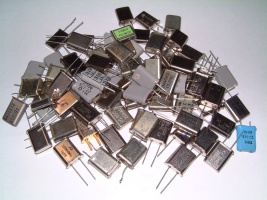
For building a good CW/SSB receiver a crystal ladder filter is a very good option. The goal is to have a bandpass filter with very sharp transitions between pass-band and stop-band in order to select only the desired signal and disregard the rest. For CW a bandwidth of 500 to 800 Hz is highly desirable and for SSB the bandwidth should be in the 2500 to 3000 Hz. Of course one can live with poor selectivity and just use a ceramic filter which are usually just good for AM or FM reception. A mechanical filter would be a better option but also very expensive. Very good crystal filters can also be readily bought, but they are hard to find and their price is also very high. A crystal ladder filter is a very good compromise: it offers good characteristics for a very low price.
Another application for a crystal ladder filter is for building an SSB transmitter. Again there are several options: ceramic filters can also do the job and are cheap, but their performance is worse; mechanical filters or readily built crystal filters are very good but very expensive. One could choose a different method of modulation and use 90° phase shifters, which work well but requires a lot of components. Here, again, a crystal ladder filter is a very good compromise.
The ladder filter uses several identical crystals (in these pages only filters with 2, 3, 4, 6 or 8 crystals are discussed) and a few capacitors in order achieve the desired bandwidth. Since all crystals must be identical, choosing them all from the same manufacturer and from the same stock is already a good idea, but this won't probably be enough and the best solution is to buy a stock of many crystals (40 or so), measure them all and select a few with very similar characteristics. Using non selected crystal will significantly degrade the performance.
The main advantage of the ladder filter is that all the crystals are identical and there is no need for having crystals cut at specific (and non-standard) frequencies. Any AT-cut crystal will do no matter if it was designed for serial or parallel resonance. Cheap CPU crystals such as 3.2768 MHz or 4 MHz work perfectly; TV crystals cut at 4.433619 MHz or 3.579545 MHz also work very well. Overtone crystals will also work, but at their fundamental frequency; for example CB crystals originally cut for 27 MHz (3rd overtone) can be used for a filter at about 9 MHz.
The scripts in the next two pages will help for selecting the crystals, determining their equivalent parameters and conceiving the filter. The center frequency of the filter will be roughly the one written on the crystal, but it will probably be several kHz apart, depending on the type of crystal, but the script will calculate it exactly. The bandwidth one could achieve is in the hundreds of Hz to the thousands of Hz, again depending on the crystals. The characteristic impedance of the filter depends on the bandwidth: narrow bandwidth filters have very low impedance (down to a few Ohms) and wider filters have higher impedance (a few hundreds Ohms) but the maximum bandwidth is limited by the type of crystals and the filter configuration.
For those who want to know what's inside a quartz, this is a picture of a crystal with transparent holder: the crystal itself is the disc in the middle (which is also transparent). The leads are connected to two strips of metallization on the quartz (one each side).
| Home | Electronics | Index | Previous page | Next page |